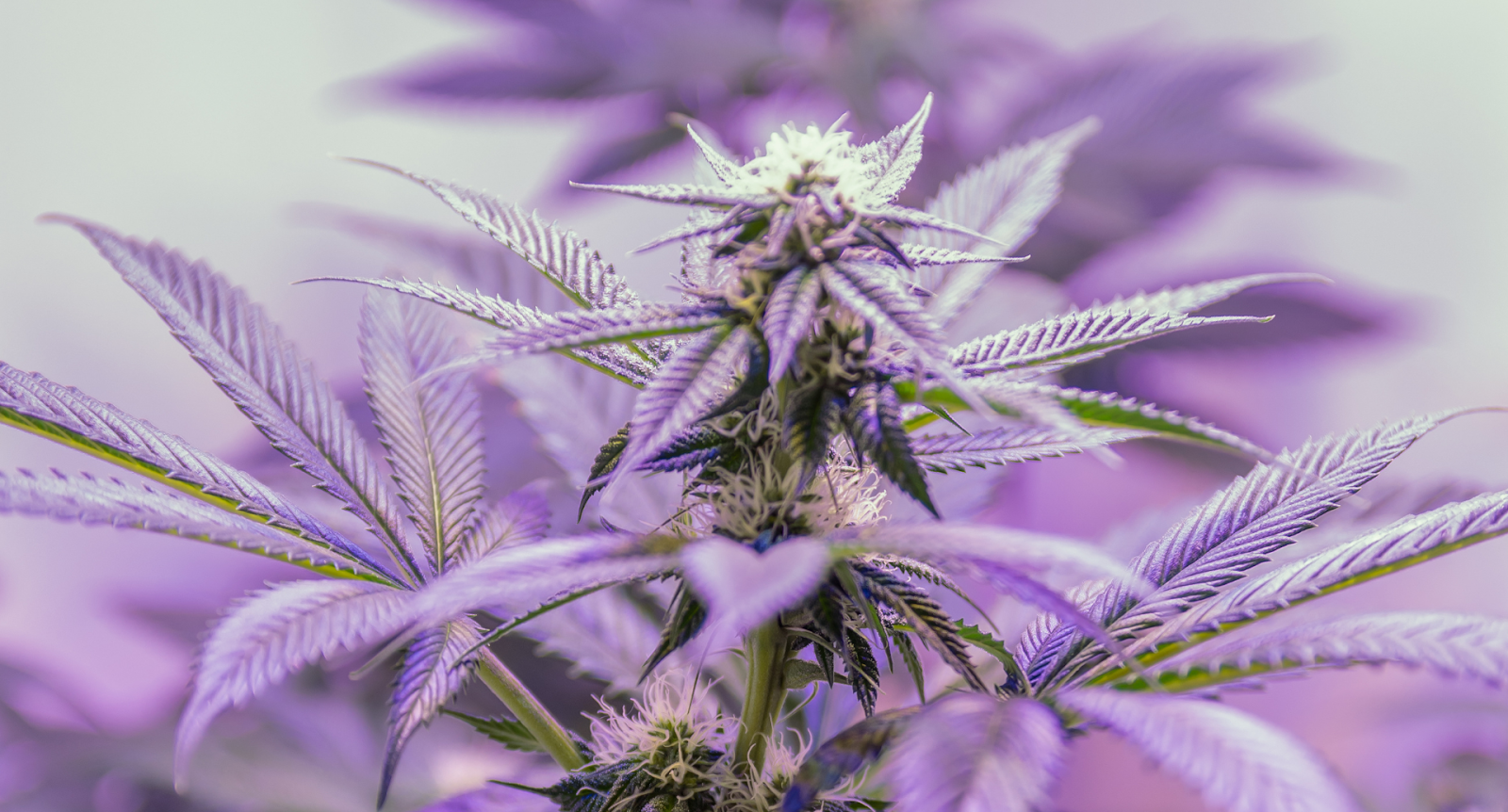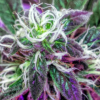No products in the cart.
Return To ShopGrape Ape Weed
Key Takeaways:
- Grape Ape’s Unique Characteristics: Grape Ape is distinguished by its deep purple hue, sweet grape-like aroma, and potent effects. Originating from a blend of Mendocino Purps, Skunk, and an Afghani landrace, it offers a rich, flavorful, and comprehensive cannabis experience.
- Versatile Consumption Methods: Grape Ape can be enjoyed in various forms, including smoking, vaping, edibles, and tinctures. While each method offers different experiences and onset times, they all provide the distinctive relaxation and comfort associated with this strain. New users should start with small doses to gauge their tolerance and adjust accordingly. For those preferring to smoke, Happy Head Shop’s Bongs offer a refined experience, enhancing the strain’s distinctive relaxation and comfort.
- Availability and Legality: Before seeking out Grape Ape, it’s important to understand the legal status of cannabis in your area. For those in regions where it’s legal, selecting a reputable source like Happy Head Shop ensures a high-quality, safe cannabis experience. Always stay informed and compliant with local cannabis laws to enjoy Grape Ape responsibly.
Grape Ape is a strain that has steadily climbed the ranks to become a favorite among cannabis enthusiasts. Its unique name piques curiosity, but it’s the distinctive qualities of the strain that truly hold attention. This article aims to shed light on why Grape Ape has garnered such a following and what sets it apart from other varieties. The strain’s rich lineage, memorable aroma, and flavor profiles, alongside its diverse effects, make it a subject worth exploring. As we discuss the details, we’ll cover everything from its origins to consumption methods, helping you decide whether Grape Ape is the right choice for your needs.
For the perfect experience, using a high-quality grinder from Happy Head Shop can enhance the aroma and potency of Grape Ape, making each session more efficient and enjoyable.
Experience The Art Of Smoking With Glass Pipes
Find Your Perfect Match – Unlock a special 20% OFF on our exquisite glass pipes collection by using code GLASS20 at checkout. Elevate your smoking sessions with Happy Head Shop today! |
Where Did The Grape Ape Strain Originate?
Grape Ape is a strain with a rich lineage, believed to be a descendant of Mendocino Purps, Skunk, and an Afghani landrace, combining the best traits of both indica and sativa varieties. Its origins can be traced back to the lush cannabis fields of Northern California, where its unique genetics were first cultivated to create a strain that stands out for its distinctive coloration and profound effects. The genetic blend not only contributes to its stunning purple hue but also to its robust flavor profile and comprehensive effects. Grape Ape’s heritage is reflected in its resilience as a plant, making it a favorite among growers and consumers alike. This strain’s genetics are not just a matter of history; they shape the experience of every user, contributing to its widespread popularity and distinct identity within the cannabis community.
What Does Grape Ape Look, Smell, And Taste Like?
Grape Ape is immediately recognizable by its vibrant purple leaves and dense buds, covered in a sticky layer of trichomes that promise potency. The strain’s appearance is a visual treat, hinting at the deep, full-bodied experience it offers. Its aroma is equally captivating, with sweet, berry-like notes mingling with a subtle earthiness that fills the room upon opening a container. When smoked or vaped, Grape Ape lives up to its name with a flavor profile that combines grape-like sweetness with a hint of floral undertones, making each puff a rich and enjoyable experience. This combination of sight, smell, and taste makes Grape Ape a sensory delight, contributing to its allure and making it a memorable strain for both new and experienced users.
What Is The Cannabinoid Profile Of Grape Ape?
Grape Ape is known for its high THC content, typically ranging from 18% to 25%, making it a potent option for those seeking significant effects. However, it’s not just the THC that defines this strain’s profile; it also contains a moderate level of CBD and other cannabinoids, which contribute to a well-rounded, full-bodied experience. This cannabinoid blend is responsible for Grape Ape’s relaxing and therapeutic effects, offering a balance that can soothe both the mind and body. While the high THC content makes it a powerful choice, the presence of CBD and other cannabinoids tempers the experience, making it accessible to a wider range of users.
What Are The Effects And Benefits Of Grape Ape?
Physical Effects
Grape Ape is predominantly an indica strain, which means its effects are largely physical. Users typically report a deep sense of relaxation and calm that spreads throughout the body shortly after consumption. This makes it an excellent choice for unwinding after a stressful day or easing into a restful evening. The strain’s potent body high may also alleviate various forms of physical discomfort, such as muscle tension, chronic pain, and headaches. Because of these properties, Grape Ape is often sought after by those looking to relieve physical symptoms without the intense cerebral high that some other strains provide. However, due to its potency, new users should approach Grape Ape with caution, starting with low doses to gauge their tolerance.
Mental Effects
While Grape Ape’s physical effects are pronounced, its mental effects should not be overlooked. Users often experience a significant reduction in anxiety and stress, leading to a state of mental tranquility. This strain may also induce a feeling of euphoria and well-being, lifting spirits and combating negative thoughts. However, it’s important to note that while Grape Ape may help with relaxation and mood elevation, its strong effects might lead to sedation, especially in higher doses. Therefore, it’s best used during times when productivity is not a priority. For those dealing with mental stressors, Grape Ape offers a peaceful escape, allowing a respite from the hustle and bustle of everyday life.
Medical Uses
Grape Ape’s combination of physical relaxation and mental tranquility makes it a favored strain for medicinal use. It is particularly effective for patients suffering from insomnia, as its sedative effects may help induce a natural, restful sleep. Additionally, its ability to alleviate physical pain and discomfort makes it a valuable option for those with chronic pain conditions, arthritis, or migraines. The strain’s stress-relieving properties also make it suitable for individuals dealing with anxiety, depression, or PTSD. It’s important for medical users to consult with a healthcare provider before incorporating Grape Ape into their treatment plan, as individual experiences with cannabis can vary. Nonetheless, Grape Ape remains a popular choice among medical cannabis users for its broad therapeutic potential.
How Do You Consume Grape Ape?
Smoking Vs. Vaping
The decision between smoking and vaping Grape Ape, like with many strains, often comes down to personal preference and health considerations. Smoking the dried flower in a joint, pipe, or bong is a traditional method that provides a quick onset of effects. However, it also involves combustion, which can produce harmful byproducts. On the other hand, vaping Grape Ape using a dry herb vaporizer like the ones from Happy Head Shop can offer a cleaner experience, as it heats the cannabis just enough to release the active compounds without burning the plant material. This method reduces the inhalation of toxic substances and can also provide a more distinct flavor profile. Both methods have their pros and cons, and the choice depends on individual health concerns, convenience, and desired intensity of effects.
Edibles And Tinctures
For those seeking alternatives to inhalation, Grape Ape is also available in the form of edibles and tinctures. Edibles, such as gummies or brownies infused with Grape Ape extract, provide a longer-lasting and more intense effect compared to smoking or vaping. However, they also require a longer time to take effect, usually between 30 minutes to 2 hours. Tinctures, on the other hand, are liquid extracts that can be taken sublingually (under the tongue) for a faster onset than edibles but longer duration than smoking. Both methods offer a discrete and convenient way to consume Grape Ape without the need for smoking, making them ideal for those seeking a smoke-free option or for those who need consistent dosing for medicinal purposes.
What Should First-Time Users Know About Grape Ape?
First-time users should approach Grape Ape with caution due to its potency. Starting with a low dose and gradually increasing based on comfort level can help prevent overwhelming effects. It’s important to wait for the full effects to manifest, especially with edibles, before consuming more. Understanding one’s own tolerance and sensitivity to cannabis can help ensure a positive experience. Additionally, first-time users should consume Grape Ape in a safe, comfortable environment and consider having a trusted friend present. Knowing what to expect in terms of effects can also help mitigate any anxiety or uncertainty about the experience. Lastly, staying hydrated and having snacks on hand can enhance the experience and help manage any potential side effects such as dry mouth or munchies.
How Do You Grow Grape Ape?
Growing Grape Ape can be a rewarding experience, thanks to its hardy genetics and the visually striking plants it produces. This strain prefers a mild to warm climate and can be grown both indoors and outdoors, although controlling the environment indoors can often lead to better yields and more vibrant colors. Grape Ape plants are relatively resistant to pests and mold, making them a good choice for beginners. They thrive in well-aerated soil and benefit from regular feeding schedules, particularly with nutrients high in phosphorus during the flowering stage to promote bud development. Pruning the lower leaves can improve air circulation and light exposure to the upper parts of the plant, leading to a healthier growth and potentially higher yields. Consistent monitoring for signs of stress or nutrient imbalance can ensure that your Grape Ape plants grow to their full potential.
When Does Grape Ape Flower?
Grape Ape typically flowers between 7 to 8 weeks when grown indoors, while outdoor plants usually reach maturity by late September to early October. It’s important to note that the flowering time can vary depending on environmental conditions and growing practices. As Grape Ape enters the flowering phase, the plants will start showing their distinctive purple hues, which can be enhanced by exposing them to cooler nighttime temperatures. This change in color does not just add to the visual appeal but is also a sign that the plants are approaching harvest time. Monitoring the trichomes on the buds can help determine the optimal harvest time; they should appear milky white or amber, indicating peak THC levels.
What Can You Expect For Yield And Maintenance?
Grape Ape is known for its moderate to high yields, with indoor plants typically producing about 450 to 500 grams per square meter and outdoor plants yielding up to 600 grams per plant. Proper maintenance is key to achieving these yields, which includes regular watering, nutrient feeding, and controlling the grow space’s temperature and humidity. Grape Ape plants are bushy and may require support to hold up their dense buds, especially in the later stages of flowering. While Grape Ape is not excessively demanding in terms of maintenance, attention to detail can significantly affect the quality and quantity of the final yield. By providing optimal growing conditions and regular care, growers can maximize the potential of their Grape Ape plants and enjoy the fruits of their labor.
Is It Legal To Consume Grape Ape?
Before seeking out Grape Ape, it’s crucial to understand the legal landscape of cannabis in your area. Cannabis laws vary significantly between different states and countries, affecting everything from possession limits to growing rights. In regions where cannabis is legal for medical or recreational use, local dispensaries are likely to carry strains like Grape Ape. However, purchasing, possessing, or growing Grape Ape in areas where cannabis is still illegal can lead to legal consequences. Therefore, always check the current laws in your jurisdiction before acquiring or cultivating any cannabis strain. Staying informed and compliant with local regulations is essential for a safe and legal cannabis experience.
Final Thoughts
As we’ve explored the distinctive qualities and benefits of Grape Ape, it’s clear this strain holds a special place in the cannabis community. From its deep purple hues and grape-like aroma to its profound calming effects, Grape Ape offers a unique experience for those seeking relaxation and relief. Whether you’re a medical patient in need of pain alleviation and restful sleep or a recreational user looking for a serene escape, Grape Ape could be a fitting choice.
To complement your Grape Ape experience, consider using a high-quality grinder from Happy Head Shop for an even burn and optimal flavor, ensuring every session is as effective and enjoyable as possible.
Read also:
- Mastering The Art Of Using A Bubbler: A Step-By-Step Guide
- How Much Should You Spend On A Dab Rig?
- How To Use A Water Pipe For The First Time: A Beginner’s Guide
Frequently Asked Questions
Is Grape Ape Indica or Sativa?
Grape Ape is mostly Indica (90% Indica / 10% Sativa).
What is the THC content in Grape Ape?
THC levels range between 18-21%.
Is Grape Ape high in CBD?
No, it has very low CBD levels, typically between 0.26% and 0.68%.
How does Grape Ape taste and smell?
The strain features grape, berry, and sweet flavors, with a similar aroma profile.
What medical conditions can Grape Ape help with?
It’s known to aid in relieving pain, stress, and anxiety.
Is Grape Ape a good strain for beginners?
It can be challenging to grow and may require extra attention, thus not recommended for first-time growers.
How long does it take for Grape Ape to flower?
It flowers in 7-8 weeks indoors and is ready to harvest in late September to early October outdoors.
What are the best growing conditions for Grape Ape?
It prefers a warm and dry climate, thriving best between 68-80°F with low humidity.
How much yield can I expect from Grape Ape plants?
Indoors, yields can reach up to 500g/m², and outdoors, up to 700g/plant.
What are common side effects of Grape Ape?
Common side effects include cotton mouth, red eyes, and dizziness.
Sources:
- de la Fuente, A., Zamberlan, F., Ferrán, A. S., Carrillo, F., Tagliazucchi, E., & Pallavicini, C. (2019). Over eight hundred cannabis strains characterized by the relationship between their psychoactive effects, perceptual profiles, and chemical compositions. bioRxiv, 759696.
- Pearce, D. D., Mitsouras, K., & Irizarry, K. J. (2014). Discriminating the effects of Cannabis sativa and Cannabis indica: a web survey of medical cannabis users. The Journal of Alternative and Complementary Medicine, 20(10), 787-791.
- Tringale, R., & Jensen, C. (2011). Cannabis and insomnia. Depression, 4(12), 0-68.
- Volkow, N. D., Hampson, A. J., & Baler, R. D. (2017). Don’t worry, be happy: endocannabinoids and cannabis at the intersection of stress and reward. Annual Review of Pharmacology and Toxicology, 57, 285-308.
- Temple, E. C., Driver, M., & Brown, R. F. (2014). Cannabis use and anxiety: is stress the missing piece of the puzzle?. Frontiers in psychiatry, 5, 57159.











